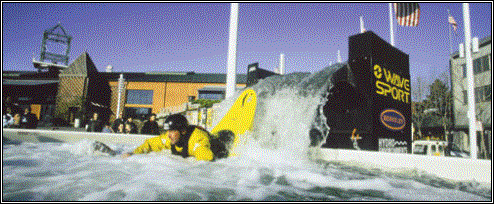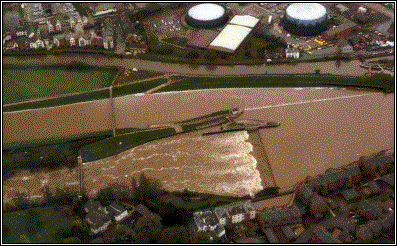
Martin Vickery
Modelling the Flow Over a Weir to Produce a Canoeist Friendly Hydraulic Jump.
For the final year project, it was necessary to find a subject that would both be interesting and contain enough depth to constitute a project. My main interest outside academic work is kayaking. It made sense to form a project based on canoeing. There are many disciplines of canoeing involving different locations, conditions and technique. Predominately the most popular canoe sport through out the world is white water kayaking, the United Kingdom and Europe are no exception. White water kayaking has recently, in the last ten years, evolved into two distinct but intrinsically linked disciplines - river running and free style.


Figure 1a-b White water river running on the river Etive in Scotland and A free style manoeuvre performed on a standing wave that is formed in a river.
White water river running is the sport or skill of navigating a canoe or kayak down a steep and fast flowing river as shown in Figure 1.1 The difficulty of the river is proportional, amongst other things, to the steepness and complexity of the navigation. Free style or ‘play boating’ was derived from the practice of white water river running skills. Initially this practice took the form of performing manoeuvres on features found in white water, such as surfing standing waves. Eventually, as general skills of paddling improved, boat performance was improved and new manoeuvres were invented, such as the ‘Blunt’ that is shown in Figure 1b. Boats evolved into specific designs to perform these new manoeuvres. Modern play boats have short slicey low volume ends and a flat hull that can, with the help of moving water and considerable skill, rotate continuously on every axis and are able to jump (bounce) clear of the water. The practice of these skills is now a recognised and established sport known as play boating.
The United Kingdom has a world presence in its production of high quality canoeists; both in play boating and river running. The ever-increasing popularity of these sports is reflected in the growth of the associated commercial industries. There are established communities of canoeists through out Britain. With the highest quality and most consistent white water in England being found on Dartmoor and Exmoor. Exeter and the other surrounding areas in Devon attract a large contingency of canoeists as the next nearest white water / play boating features are in London, North Wales and Nottingham. White water is rain dependent. It is impossible to navigate a river with no water flowing down it, let alone find a feature suitable for play boating. In the summer months many of the local rivers are little more than steep streams. The alternative is to find non-rain dependant features such as tidal races, bores, surf, and artificial white water sites or to travel abroad.
A large problem canoeists have in the United Kingdom is access to rivers. Many of the rivers are riparian owned and are closed during the summer due to fishing leases. Fishing rights are expensive and exclusive, anglers do not appreciate canoeists disturbing this exclusivity. Because of the lack of rain and access, there are plans underway to create a major self-contained artificial white water course in Exeter that would be of immense value to the region and its economy. The planned completion date is 2005

Figure 2 The Wave Sport Box.
Other than the large scale construction of an artificial course, there is currently nothing to cater for the need of canoeists. It would be immeasurably beneficial to create an accessible temporary feature suitable for play boating during the summer. This problem has been addressed before and solutions such as the Wave Sport Box as seen in figure 2 and Wave-Loc, an artificial surf wave formed by a small volume of water with a high velocity flowing over a solid wave shaped surface. The project’s aim will be to study the possibility of creating a play feature by channelling the flow over a weir to form a hydraulic jump that canoeists would find useful. There are many forms of hydraulic jumps that can be used for play boating, from standing waves to broken waves known as 'holes' and 'pour-overs'. To create standing waves or 'holes' that can be used for play boating a large flow of water is needed over a comparatively small area, making the hole deep enough so that both manoeuvres on the horizontal and vertical plane can be performed. A pour-over only requires a moderate flow and is more dependant on the shape or particle path of the water, its depth is not created from a large volume of water but a deep plunge pool. Due to the above constraints of lack of water the more feasible hydraulic jump would be a pour-over. The minimum requirement that would make a pour over useful to canoeists is to be able to perform manoeuvres in the vertical plane. The most commonly performed manoeuvre in the vertical plane is the cartwheel sequence as shown in figure 3, with a lot of skill this rotation can be performed continuously.

Figure 3 The Cartwheel sequence.
There are three key elements that make up a pour-over, a suitable flow of water, a large difference in head and a deep plunge pool. Including the problem of access then there are four location constraints. The only central river in the South West with a suitable volume of flow through out the summer is the river Exe. The river Exe has only two area of free access during the summer that is in Tiverton and Exeter, there are five places in these areas that have a suitable head loss and these are the major weirs. Most of the concept ideas involved creating a large structure that would funnel the water that flows over the weir, but when examining each of the locations a sluice gate was found at Trew's Weir in Exeter, this is shown in figure 4 the sluice gate can be located in the aerial photo at the bottom of the photo (on the left looking downstream) where the water is diverted for a few metres and then joins the main flow a few metres down stream from the weir face. The sluice height can be changed to allow a greater flow of water, thus doing away with the need for a large funnelling structure. The structure of the sluice gate involves a small reservoir area upstream of the gate, the sluice gate, a long sloping channel followed by a drop on to a small submerged ledge in the deep plunge pool. In order to create a model or the sluice gate a lot more information on the sluice gate, the flows and the water heights was needed.


Figure 4a-b Trew's Weir.
After obtaining details of the flow rates of the river Exe for the summer months from the Environment Agency and surveying the location it was possible to calculate the flow levels over the sluice and the difference in head (surface levels) upstream and downstream of Trew's weir. The sluice was then modelled using a CFD package FLUENT5.5 the computational models were verified using analytical models and experimental data and a suitable mesh refinement. This is shown in figure 5 where the black lines indicate a free surface or wall. The models were split at suitable places in order to reduce computational costs.


Figure 5 The sluice at Trew's weir modelled using FLUENT5.5
The model was then modified so that the sluice was lowered to approximately half its normal height inorder to let approximately two cumecs over it in normal flow. A lip was also introduced at the end of the chanel inorder to controll the the entry angle of the water into the plunge pool and to allow the water to clear the submerged ledge and form a pour over as seen in figure 6.


Figure 6 The end of the chanel and plunge pool when modified.
The shape of the hydraulic can be clearly seen in figure 6, that is the shape of a clasic pour over style of hydraulic jump. With time the water will erode away the silt and sediment of the floor of the plunge pool and the shape of the feature will improve for canoeists. By opening the sluice and introducing a lip or a kicker board this project shows the possibility of beeing able to create a pourover with enough flow that a feature could be made that would suit the needs of canoeists.